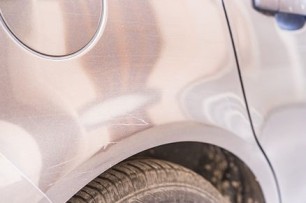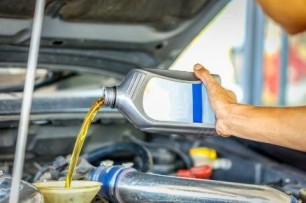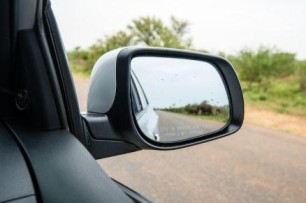General Insurance Blogs, Articles & Updates by - Magma HDI
Have us call you
- RENEW YOUR POLICY
- BUY NEW POLICY

Here are a few tips for maintaining the optimum tyre pressure in two-wheelers
Tyres are the least talked about part of a bike and usually get tossed to the side. But it is crucial to check your two-wheeler’s tyres regularly because they go through a lot. Whether you are riding on a metal road or rough surfaces —they have to be able to hold their shape. But, quick-fix solutions like tyre pressure can do so much for your tyres.
Imagine riding your bike, and you realise there's a flat tyre. This can interrupt your ride due to the waste of time. Also, sudden faults in the tyres are potential risks to the rider's life and even damage the bike.
Tips for maintaining the optimum tyre pressure:
Taking care of your bike's tyres isn't a big task. If you remain a little attentive, it's possible to avoid any breakdown-related issues. However, a big problem that one needs to avoid is the accident and financial worries attached to it. To deal with these, consider buying insurance plans. Getting a 2 wheeler insurance policy is like buying a shield for your two-wheeler.
And luckily, there are four tips to help you avoid tyre-related accidents while riding your bike. Maintaining optimum tyre pressure is crucial to minimise mishaps on the road.
1. Are your tyres correctly positioned:
When checking your bike, you should always check the tyres to see if they are in the correct position. Also, check for any punctures as sharp objects such as glass can hamper the quality of tyres. Make sure to move the tyre forward and back to check the whole surface thoroughly.
2. Check the tyre pressure:
One of the best ways to protect your two-wheeler is to examine the air pressure. When inflating your tyres, you can extend their lifespan and improve handling. Make sure to check the air pressure before every ride. As the bike heats up, air pressure can change, and it is essential to keep track of the air pressure level for your bike.
3. Recommended air pressure:
Keeping your motorcycle's tyres at the recommended air pressure is essential. Ask the service centre or check your bike manual to know the recommended tyre pressure, and ensure you maintain it. Also, to avoid sliding on wet roads, make sure your tyres are in good shape. Check the treads for wear and make sure they are not bald. If there is a decrease in an inch or quarter bald track, you should consider replacing the tyres.
4. Avoid maximum inflation:
When filling your tyre with air, be mindful that the sidewall states the maximum pressure. The recommended amount is always lower than the maximum. Excessive air filling can cause considerable damage to the tyres and increase the probability of tyre burst, creating a life-threatening situation for the rider and fellow drivers around him.
With an increasing number of road accidents and fatalities in India, 2 wheeler owners must be well-protected from any unfortunate mishaps. So, make sure you get a 2 wheeler insurance plan, drive safely, and stress-free. Also, use the tips mentioned above to take the best care of your bike’s tyres and leave no scope for negligence.
Click HERE to buy the best 2 wheeler insurance.
Disclaimer: The information provided above is for illustrative purposes only. To get more details, please refer to policy wordings and prospectus before purchasing a policy.

Let's understand how a central locking system impacts a car's safety
Since its implementation, the central locking system has become one of the essential safety features in a car. It's a combination of electronic and mechanical components that only allow access to authorised individuals.
Earlier, central locking systems in automobiles used a compressed air mechanism with separate vacuum reservoirs that triggered the locks of all four doors when the key was inserted and turned in a lock. Today's systems use wireless or infrared control, which can activate the mechanism from a distance.
In today's post, we will look at the functioning of the central locking system and how it impacts a car's safety.
The four main components of a central locking system.
1. Actuator:
An actuator is an electric motor that controls the car's central locking system. This component is built into the door and consists of a combination of mechanical latches.
2. Transponder:
It is a system built into the key's bow that determines whether the correct key is being used. As the key approaches the ignition lock, the transponder code is read. When the correct code is scanned, the electronic immobiliser sends a signal to the engine to permit it.
3. Remote Controller:
Remote controllers are increasingly being used in all cars. They are designed to replace the function of the key systems completely. The remote control includes electronic circuitry that sends coded instructions via infrared rays to the receiver located inside the vehicle to permit a keyless entry.
4. Start and stop system:
Unlike traditional ways, which required a key to be inserted into the ignition lock to start the car, engines are now being started using keyless systems where a transmitter – also serving as the central locking controller – is scanned into a reader in the vehicle. Later, the engine is started by pressing a button.
Safety advantages of central locking systems:
• The driver has better control over all the doors. The central locking system allows drivers to lock or unlock all four doors by pressing a single button. This is very convenient since the driver doesn't have to worry about unlocked doors while the car is in motion.
• Since the code is digitally encrypted, it is tough to make duplicate keys.
• If your key is ever stolen, you can simply remove the access right from the software on your phone. It connects with the car's digital lock and terminates access rights. Some automobile manufacturers even allow removing the access remotely.
• In more sophisticated systems, the car's door automatically locks itself after reaching a specific speed limit. As a result, no one, especially toddlers, can open the door by mistake —this helps avoid serious accidents.
• In case of an accident, a central locking system smartly unlocks the door so that help can reach you without having to break anything.
What else assists post-car accidents? Comprehensive car insurance. You can claim all the expenses involved in repairing and servicing your car under your car insurance policy's scope
A central locking system is essential for a family vehicle in practical usage. The ease of access and security that it provides make life easier for all automobile owners. Having a central locking system in your car provides extra security and brings down your car insurance premium. All the reputed car insurance companies encourage car owners to adopt convenient and safe practices. So, go for a central locking system in your car to enjoy a wide array of benefits and deals that you shouldn't be missed out on.
Click HERE to buy car insurance in hassle-free steps.
Disclaimer: The information provided above is for illustrative purposes only. To get more details, please refer to policy wordings and prospectus before purchasing a policy.

Let's talk about car fenders and how they are distinct from regular bumpers
As a car owner or enthusiast, it's prudent to educate yourself about vehicle parts. The most confusing of them are fenders and bumpers that keep your car safe. You may have heard the term "fender-bender" from drivers when they get into a car accident and wondered, "What does it mean?" Fender and bumper damages refer to physical damages to your cars, such as dents. If you have recently bought a new car, this article will help you understand the difference between these terms.
However, before diving into fender vs. bumper issues in detail, we advise you to buy new car insurance to ensure your vehicle gets adequate protection against accidental damages and a hassle-free repair and servicing.
What is a car fender?
The fender has been a part of automobiles for a long time now. It is the part of the car that covers the wheels. The section where the fender goes is popularly called the "quarter panel." The quarter panel is the rounded corner of the car that protects the wheels.
In older vehicles, the fender used to be more pronounced. Whereas nowadays, with the modernisation of the structural design of cars, fenders have taken a flatter shape, complementing the car's frame.
Car fenders are an essential accessory for your car, as they play a crucial role in keeping the vehicle and its occupants safe. As the car moves, the tires grab and throw anything that comes in its path, such as small rocks, mud, water, etc. Fenders provide resistance against wind and roadside debris while protecting surrounding areas and nearby people from projectiles from your tyres.
What is a car bumper?
A car bumper has a "bumping" function, which means it acts as a protective perimeter to the body of your car and prevents other objects or vehicles from impacting it. In simple words, it reduces the impact of a collision by absorbing minor shocks. You can find bumpers in two places in your car, one in the front and another in the back.
Car bumpers may not prove very beneficial in protecting your vehicle from high-speed crashes, but they are quite valuable for safety during minor accidents. They also serve to protect pedestrians from severe injury in case of a collision.
Just like fenders, bumpers have also reduced in their size. Previously, they were mainly used for decorative purposes, and people came up with new stylistic designs. However, they have gained quite much attention in the automobile industry in recent years. They are no longer considered decorative items but essential for safety purposes. The effectiveness of rear and front bumpers has saved the lives of numerous car accident victims.
Several car owners struggle to understand the parts of their vehicle, making it challenging to communicate with the mechanics about car troubles. However, educating yourself about them can make all the difference when it comes to the proper maintenance of your vehicle.
Similarly, think of investing in the security of your car and buying new car insurance to ease the concerns that can empty your pockets and leave you frustrated. Understand your role as a responsible owner and do whatever is necessary to keep your four-wheeled companion safe.
Click HERE to buy new car insurance with the best benefits.
Disclaimer: The information provided above is for illustrative purposes only. To get more details, please refer to policy wordings and prospectus before purchasing a policy.

Useful tips to make healing and recovery of fractures fast and less painful
Of the many injuries we are familiar with, a fracture seems to be the most painful. Not only it is excruciatingly painful, but it also takes a long time to heal. A fracture can slow you down, even for basic day-to-day chores. The healing is given ample time to ensure that the bones are correctly aligned. But having said that, waiting for your fracture to heal can be tedious.
The healing of a fracture covers three main stages: Inflammatory, reparative, and remodelling. During the inflammatory stage, special cells assemble in the injured area and cause redness and swelling. This is an indication to the body to stop using the affected area. The first bridge between the broken bones is made here as a blood clot or hematoma.
During the reparative stage, a soft bone or callus takes the position of the blood clot and holds the broken bones together. This soft callus is not strong enough to handle weight and movement. Over the subsequent weeks, the callus becomes stronger and can handle movement.
During the final stage, the normal bone replaces the callus entirely, and over a few weeks, the bone is back to its original condition.
In this article, we will look at the few things we can do to accelerate the speed of recovery.
1. Restricting movement:
The more the movement, the longer it takes for the bones to heal. To heal properly and quickly, the best method is immobilisation. Castes and plasters are the most common ways of giving your bone the support it requires while also restricting any painful movement.
If the fracture is more severe, the doctors might rely on screws, plates, or wires to keep the bone fragments intact. Always remember to consult a doctor in case of pain or discomfort.
2. Improving food habits:
A weak bone can take longer to heal. Vitamins and minerals are vital components of a healthy body. The essential component for bone development is calcium. Include food items such as milk, cheese, and other dairy products that contain high amounts of calcium that your bones require. For your bones to absorb maximum calcium from these food items, your body also needs Vitamin D. Vitamin D helps the bones effectively absorb the calcium from various food sources.
Avoid smoking and alcohol consumption. People who indulge in these habits experience slower and more painful healing. Avoid food with high sugar and salt content. Excessive sodium or sugar removes calcium from your body and significantly slows down the repair of broken bones.
3. Physical therapy:
Physiotherapy can work wonders for bone repair. Blood flow is an essential part of bone healing. Therapy under the guidance of a physiotherapist can help you regain strength and a greater range of motion. There are also some exercises that you can occasionally do. This ensures that your muscles and bones do not get stiff over time while in a cast.
4. Post care:
After the cast is taken off, try not to test the broken bone. Do not put a lot of pressure on the bone to ensure if your bone has healed or not. As tempting as it may seem, give your bones time to adapt to the surroundings without having external support.
These are a few valuable tips you can follow if you want a faster recovery of broken bones. All the methods mentioned above are simple practices you can incorporate into your daily routine. Healthy eating habits, regular exercising, and timely body check-up are essential to maintaining an overall healthy lifestyle.
This article is also a reminder for you to do your health insurance policy renewal. Accidents can be expensive, with the medical bills skyrocketing. Hence timely health insurance policy renewal is non-negotiable to avoid stress due to health problems.
Click HERE for health insurance policy renewal.
Disclaimer: The information provided above is for illustrative purposes only. To get more details, please refer to policy wordings and prospectus before purchasing a policy.

Important tips for selecting the best engine oil for your car
Regular car maintenance is a worthwhile investment since it allows a vehicle to operate more effectively and safely. Moreover, it helps avoid the need for expensive repairs in the future. Changing the engine oil improves the performance of your engine by spreading heat and keeping an appropriate temperature in the combustion chamber. In addition, you must remember that a well-maintained car helps you secure a car insurance renewal easily with added advantages like no claim bonus.
It is critical to use the proper lubricant for your vehicle to achieve optimal engine performance. There are many types of car engine oils available, and determining which one is best for your car is not an easy task.
How do you know which engine oil is best for your car? Here are the things you must consider.
1. Oil Viscosity:
When it comes to engine lubricant or engine oil, viscosity is a measurement of the thickness of the oil and the resistance to flowing. It is necessary to match the oil viscosity to the ambient temperature since thick oil does not agitate around the engine. Optimal viscous lubricant promotes energy efficiency while also preventing friction between components. Look at the care guide for your car's oil needs.
2. Analyse the previous engine oil's performance:
One of the essential things you should do when changing your engine's oil is to assess how well the prior engine oil performed. Changing your engine oil at specified intervals is vital to ensure smooth performance and safety.
Suppose the previous engine oil was refined, and there was no need for engine maintenance. In that case, you can use the same oil and brand without hesitation. It's best to choose an oil with the same manufacturer certifications as the one specified in your car manual if you can't find the one you need.
3. Type of car you have:
The type of vehicle is the most crucial consideration when selecting engine oil. There are several important factors to consider when buying engine oil for your car, including whether it is old or new, if it runs on gasoline or diesel, and if it has a high-performance engine or not, the brand, the series, and so on.
4. Follow the advice of the manufacturer:
It is suggested to follow the manufacturer's guidelines for engine oil changes in your vehicle. The importance of these guidelines becomes much more apparent when you own a new car that is still covered by the manufacturer's warranty. Use only the engine oil recommended by the manufacturer during this period because using a different oil could invalidate the warranty and affect your car insurance renewal.
5. Environmental factors:
The choice of engine oil is influenced by whether or not the vehicle is subjected to high-temperature conditions. Choosing an engine oil that can handle low and high temperatures is essential when driving in harsh climates.
It is critical to choose the appropriate engine oil for your engine to run at peak performance. Furthermore, the proper engine oil will improve the engine's performance and the car's overall fuel efficiency.
It is highly suggested that car insurance renewal be done before the due date to receive uninterrupted insurance benefits for a prolonged time. So consider these five factors the next time you're shopping for engine oil to get the best results.
Click HERE to get your car insurance renewal done before expiry.
Disclaimer: The information provided above is for illustrative purposes only. To get more details, please refer to policy wordings and prospectus before purchasing a policy.

How to ensure maximum visibility by adjusting your car mirrors efficiently
Driving is a predominantly visual activity. Only learning the controls of the car is not enough. Good visualisation is one of the essential skills to develop when driving a car. Although you must concentrate on the road ahead, it is crucial to have a clear view of the sides and back of the car as well. Adjusting the side and rearview mirrors is vital to ensure a well-rounded view while driving.
Further, you should rely on emergency financial help by investing in dependable motor insurance India plans in case of road accidents, as it is always better to be safe than sorry.
All cars have blind spots; therefore, adjusting your rearview and side mirrors to the optimum can ensure maximum visibility and safety on the road. In this article, we tell you how to use your car mirrors efficiently and avoid the chances of accidents while driving.
1. Rearview mirror:
The rearview mirror, positioned next to the driver’s seat slightly above their eye level, is used to see the road behind and if any cars are approaching. The driver must adjust the rearview as per their height and comfort as soon as they get into the driver’s seat.
To adjust the angle of the mirror, sit up straight in a comfortable position, hold your head still, look into the rearview and shift it until the back or rear window is entirely visible in the mirror. Do this to avoid any blind spots. If more than one person is driving the same car, make sure to check the rearview mirror every time you get into the driving seat and readjust it to the best angle, in case it has been shifted as per another driver’s comfort.
When driving at night, flip the tab at the bottom of the rearview mirror that helps dim the light reflected by the headlights of the cars approaching behind you that may strain or blind you. In addition, some advanced car models enter and exit night mode to aid your visualisation.
2. Side mirrors:
Every car has a single side mirror on the left and right sides of the vehicle, respectively. As they are located outside of the car, it can be difficult to manoeuver them from inside. While many modern car models have levers or buttons that help adjust the side mirrors from the inside, some of them may not.
If your car does not have a lever or buttons to adjust the side mirrors, make sure to do so manually, right after you adjust the rearview mirror. Sit upright in the driver’s seat, first glance to one side, and adjust that mirror to an angle that helps reflect the side of the road. Shift it to a wide angle to get a comprehensive view of the side of the road. Repeat the same method for the mirror on the other side. If you have a lever or button inside the car, angle the side mirrors using it. The side mirror should provide a wide sideways view in just a simple glance.
The pro tip is to adjust the side mirrors to an angle that allows you to see right from the side of the road to the very back, including the approaching car, to maintain a safe distance.
Following these few tips to adjust the car mirrors can vastly improve your visualisation and assist you considerably while driving. It leaves very little room for errors or accidents. Apart from angling the mirrors, you must also check the wheel alignment, tyre pressure, oil levels, acceleration, and brake control to ensure safety before hitting the road.
Also, prioritise investing in motor insurance India plans and get the perks of financial coverage in case of loss or damages during accidents. Add value to your possession and get the best returns with assured safety.
Click HERE to know more about motor insurance India plans.
Disclaimer: The information provided above is for illustrative purposes only. To get more details, please refer to policy wordings and prospectus before purchasing a policy.

How mice threaten your bike and how you can prevent it
Indoor rodent infestations may have significantly reduced over the years; however, they still pose a threat outdoors. While we hear several stories about the damage caused by rodents and insect infestations in cars, we rarely hear about how badly they can damage two-wheelers.
Rodents, particularly mice and rats, are primarily attracted to areas where they can find ample warmth and hide. For them, bikes that have been stored away in garages for the long term make a perfect home. Although these mice usually take shelter in cars, bikes are a perfect warm spot for them, specifically in the winter months.
What are the threats caused to your bike by mice?
If you think rust is the worst thing that can harm your bike, you may be wrong. Mice and other such rodents can be far more damaging to your two-wheeler. From chewing on bike parts and wiring to building nests inside your engine, mice can cause terrible damage.
Mice are quick to chew into various parts of the bike, especially wiring. This can cause the engine and other parts to fail and is very difficult to fix. These damages incur high costs for the maintenance of your bike. In addition, it can be challenging to reach and repair the internal parts of the bike that have been damaged, causing unfavourable wear and tear in the process.
The nests created in internal parts of the bike are another major issue. Mice store food and other materials in the nests, which can clog the engine. They carry diseases and germs that can be detrimental to your health. If the nest is built near the air filter, there is a considerable danger of expelling rodent excrement every time you start the bike, leading to the spread of airborne viruses.
How to keep mice away?
Whether you are trying to get rid of the mice or are simply taking preventive measures to protect your vehicle, these few tips will go a long way in avoiding any more damage caused by rodents:
1. Mice try to find places that humans or other animals don’t regularly use. A stored bike in the garage or outdoors is one such place. The easiest thing to prevent this is to take the bike out for a ride frequently.
2. A simple mouse trap can help catch the ones that may be inside your vehicle. Keep the bike in a shed or enclosed area, set enough mouse traps around and underneath the bike, and check after a couple of days.
3. You can find many mice or rodent repellent sprays and medicines in local stores or online. Spraying these all over the bike will help chase away all the mice dwelling in and around the two-wheeler and prevent any more rodents from coming near it.
4. Block all mouse holes or hiding places in the garage where you store your bike. Making it a rodent-free zone is crucial. Avoid parking the bike in forested areas or lands with tall grass to avoid any future infestation.
5. Mice have a strong sense of smell and can be highly affected by it. Applying peppermint oil on tiny buds of cotton and placing them in various corners of the vehicle can help drive them away.
These tips may not undo all the damage caused to your vehicle, but it’s always good to be aware. So, be wise enough to have bike insurance so that you can recover the damage caused by mice. Also, if your bike insurance plan covers non-collision damages, you can easily file a claim.
Click HERE to get the best deals on bike insurance.
Disclaimer: The information provided above is for illustrative purposes only. To get more details, please refer to policy wordings and prospectus before purchasing a policy.

Plan to enrol your kids in these exciting activities and make the monsoon season enjoyable
The onset of monsoon is a gift for humans, animals, and plants. The lush greenery, the sweet smell of moist soil and the cold winds are a much-needed respite from the scorching summer months. But with all the monsoon goodness comes a set of challenges as well.
Children end up locked inside their houses, hoping for the pouring rain to go away. If you are a parent and you notice your kids growing increasingly impatient, this article is just for you. This article will look at all the activities you can enrol your kids in for a productive and fun monsoon season.
1. Take up a painting class:
Painting is an expressive art form. It is visually stimulating and allows your child to explore different colours and expression mediums. It gives your kids the opportunities to develop creatively and imaginatively.
This gives them the freedom to visualise and metaphorically paint the picture they want. You can help your children navigate the different types of famous artworks for inspiration. Later you can encourage them to join a painting class or workshops and learn to paint their imagination with passion.
2. Sports are always a yes:
In these distressing times of fast-paced technological advancement, we all have fallen sick and are easily prone to multiple health issues. Our bodies have become glued to the smart phones, and all you want is readily available with just one touch and tap of your phone. Rain can put a damper on your kid's physical activities.
Since being outdoors is a complete no-no, kids end up glued to screens. Indoor sport is your solution. Games such as table tennis, carrom, and chess are a few sports kids can play in the comfort of being indoors. Do not let rain be the reason your kids stay away from the fun.
3. Never say no to learning music:
Music, like painting, is again an expressive art form. The sounds stimulate your brain, which can then interpret different versions of tunes and rhythms. They help your child distinguish between various moods and emotions, thus enabling them to create their music. Notice how your kids pick up different notes from the song. Understand and encourage them to pursue various music skills and may also enrol in a music class.
4. We have all heard of abacus:
Abacus and mental maths tips and tricks will always be everyone's favourites. It doesn't harm learning quick tricks to help your child academically in the future. This enables the brain to enhance its analytical and logical power. Abacus classes can help your child improve their logical reasoning and make brisk calculations.
Ask your child if these activities interest them, and let them take the lead while staying indoors during the monsoon season. Parents must always focus on planning experiences to help their children be independent and happy. Don't let the rain wash out the excitement of your children. Monsoon can be fun, too, if activities are planned rightly.
Apart from the skills development, you should consider the plans for keeping the kids protected under any unforeseen circumstances which might arise during different walks of life. One of the best gifts your child can get is insurance benefits. As a parent, you must discuss your options and purchase the best general insurance for catering to your children's needs in the best ways possible.
Refrain from taking drastic decisions while buying general insurance. Take your time, do the best research, understand your child's requirements, and accordingly select the plan that is the best!
Click HERE to learn more about how purchasing general insurance.
Disclaimer: The information provided above is for illustrative purposes only. To get more details, please refer to policy wordings and prospectus before purchasing a policy.


